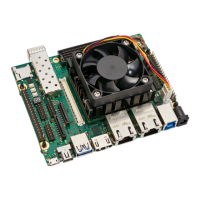4 I2C Communication
4.1 Overview
The I2C bus on the Mercury XU5 SoC module is connected to the MPSoC device and to the EEPROM, and is
available on the module and debug connectors. This allows external devices to read the module type and
to connect more devices to the I2C bus.
The I2C clock frequency should not exceed 400 kHz.
Warning!
Maximum I2C speed may be limited by the routing path and additional loads on the base board.
Warning!
If the I2C traces on the base board are very long, 100 Ω series resistors should be added between
module and I2C device on the base board.
4.2 Signal Description
Table 40 describes the signals of the I2C interface - the pins are connected to both PS and PL. All signals
have on-board pull-up resistors to VCC_3V3.
All signals must be connected to open collector outputs and must not be driven high from any source.
I2C_INT# is an input to the MPSoC and must not be driven from the MPSoC device.
Level shifters are used between the I2C bus and the PS/PL pins, to allow I/O voltages lower than 3.3 V. Please
make sure that all pins are configured correctly and no pull-down resistors are enabled.
Signal Name PS Pin PL Package Pin Connector Pin Resistor
I2C_SDA MIO11 C12 A-113 2.2 kΩ pull-up
I2C_SCL MIO10 D12 A-111 2.2 kΩ pull-up
I2C_INT# MIO12 - A-115 4.7 kΩ pull-up
Table 40: I2C Signal Description
4.3 I2C Address Map
Table 41 describes the addresses for several devices connected on I2C bus.
D-0000-445-001 55 / 64 Version 07, 25.07.2019

